There are a lot of words that could describe the result of Philadelphia Union’s 3-2 loss to DC United Sunday. Frustrating and disappointing come quickly to mind.
But the one that fans, coaches, and players cannot escape is much worse: Inevitable.
From the moment the Union went up 2-0 in the fourth minute, there was a sense of confusion which quickly gave way to uncertainty, which eventually gave way to dread and, after Nick DeLeon’s tying goal in the 66th minute, inevitability.
Philadelphia was the better team for 35 minutes to open Sunday’s match, but they were the lesser team at the final whistle.
What changes turned a one-sided match on its head? And why didn’t the Union have a better response once the tide turned? We will try to answer the first question. The second will — hopefully — come up at Jim Curtin’s presser this week.
Because Philadelphia Union should have left RFK Stadium with at least a point.
Speed of play
Let’s start with the obvious: The Union are extremely dangerous on the break. Or, put in harsher terms: The Union are only dangerous on the break. After going ahead by two, the Union took three more first half shots in the DC box. All of them came on the break. In the second half, a deep defensive set neutered the counterattack and the Union did not take a shot until Fred’s 75th minute effort after the match was tied.
The secret ingredient to Philadelphia’s offensive success is undoubtedly the speed of play out of the back. When the Union transition quickly from the back four past the midline, they present real and immediate problems through Cristian Maidana, CJ Sapong, and wingers that can create their own space below the box. However, in any other scenario the Union are neutered by an odd lack of patience and a frustrating lack of movement.
All season, blame has been placed on the wing players, who push high then seem to disappear into opposing defenses like some sort of useless ninjas. But it is clear that the problem is larger than Sebastien Le Toux and Andrew Wenger.
The Union rely on Cristian Maidana for the majority of their offensive creativity, with Vincent Nogueira kicking in a fair amount whenever he is healthy enough to go the full ninety (which may not be for a while after he said following the loss that he had injured his quad). Maidana almost exclusively sets up shop near the touchlines about 20-30 yards from goal. Find him anywhere else and you are likely to a) Find him without the ball, and b) Find him during a Union loss.
Theoretically, Maidana can create overloads by sneaking off to the wings and running the offense. Yet that has not been the case. Instead, Maidana simply collects the ball on the wing and plays a ball into the center of the pitch or crosses it. And as Philly’s first goal showed, this is not a strategy without merit. If Maidana can drag a midfielder to the edge and find Sapong in the box, Philly is an incredibly dangerous team.
However, Maidana and the wing players still lack a fundamental understanding of the wingers’ roles. Should they be checking central when the Argentine is on the wing? Should they run in behind? There may be no correct ‘should’ answer. But the evidence is clear: Right now the wingers don’t really know what to do. They get stuck out there with Maidana and act as neither an outlet nor an overload.
Against Portland, the Union were bailed out by the Timbers’ deep midfield, which allowed the ball to be moved off a wing, through Nogueira, to the far side of the pitch. Without Nogueira’s aggressive checking, those dangerous wing positions became black holes unless Philly was in a counterattack. Resolving this issue is would finally make the Union more than a one-note offensive team.
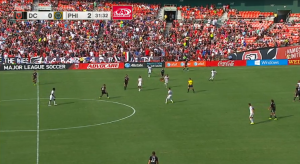
In the buildup to the penalty, Zach Pfeffer did not step to Davy Arnaud, allowing the vet to pick out a pass and lope into the box.
Defensive pressure
When Fabinho went down with a minor arm injury, Ben Olsen snuck over to the Union bench and stole their defensive tactics board.
Or at least that’s a fair assumption based on what happened next.
For the final ten minutes of the first half and most of the second half, DC United methodically probed Philadelphia’s defense with a patient, outside-in approach. Here’s how it went: Play the ball to one side, wait for Sapong and Maidana to rotate over, then play the ball across the back to the other side. Once a winger steps up to the fullback, play the ball inside to Perry Kitchen or Davy Arnaud, who can then hit a longer pass back to the touchline where the winger has taken up space behind either Le Toux or Ayuk. Once the Union fullback steps high, play the ball back into the middle (or just dribble there) to allow Chris Korb or Taylor Kemp to push forward.
Over and over this same sequence occurred on Sunday. The opening goal came off a slight twist in the narrative when Nick DeLeon simply waltzed past Zach Pfeffer’s half-hearted defense, picked his head up, and found Korb behind Fabinho. The details were different, but the theme remained the same: Draw the Union winger too high or too narrow, then use that to either attack the space in front of the fullback or pull him high and attack space behind. It’s weird that a tactic can be so simple, or so effective.
Philly had no answer. The Carroll-Pfeffer midfield was too deep to pressure the first ball inside from the DC fullback, but Le Toux and Ayuk kept pressing that fullback even without support. This left a gaping hole in the Union’s defensive shape that Nick DeLeon on the right and, for the final 55 minutes of the match, Fabian Espindola on the left, used as a lab for ever more incisive attacks.
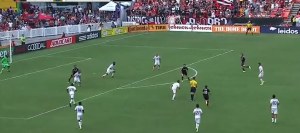
White and Edu allow Saborio to pull them far too deep into the box, gifting Espindola time and space in a very dangerous area. The resulting shot led to DC’s second goal.
Lay blame?
Here is a case in which it is easy to point the finger at Jim Curtin, Mike Sorber and the coaching staff and ask, “Why don’t you fix this?”
But then more questions come up: How? Do you ask the wingers to back off? Do you ask the central midfielders to step up? Do you ask the whole team to step up? Do you tell Maidana to be a bit more disciplined in his lateral drifting?
These are all reasonable approaches. But then you have to face the harsh reality that is the Philadelphia Union roster. (Remember: This is a club that “solved” their fullback issues by waiting until Fabinho came good then trading away their positional depth because it was the only value they had outside of the starting eleven. Also remember: Fabinho was apparently a hot commodity before the expansion draft but was deemed too valuable to let go. But Sheanon Williams and his longer-term consistency? Apparently not too valuable).
The Union use Zach Pfeffer, who has been groomed since age 16 to be a US international attacking midfielder, as Vincent Nogueira’s backup. Nogueira is a player of such industry and talent that he essentially defines his own position as almost a creative Gennaro Gattuso. Pfeffer, in contrast, is a very young player who, at every level, has been an attacking midfielder a la Chaco Maidana.
So yes, Pfeffer’s defense left a lot to be desired on Sunday. But ask yourself: What would Chaco in that same role have looked like? He would have looked like Pfeffer without the youthful bounce in his step after he got beaten.
Around Pfeffer, Philly has the hard-working converted striker Sebastien Le Toux and the teenaged Eric Ayuk. Le Toux is a hot-n-cold playmaker, and when he is cold he does what he always did as a striker: Use his superior fitness to chase down defenders and try to force turnovers. At times, this strategy works well. But when it doesn’t, it leaves a gap that is low hanging fruit for any opposition coaching staff that spends an hour in the film room.
Ayuk is, again, a teenager playing his first minutes in anything close to a high level. His defense is, as should be expected, a work in progress.
All of this is not meant to call players out. Quite the opposite.
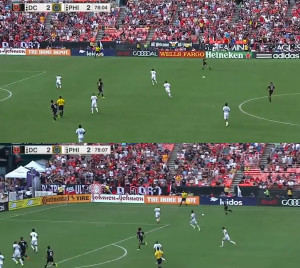
So much wrong on the 3rd goal: Fred leaves Espindola to guard empty space, Le Toux and Fabinho both step to Korb and leave DeLeon alone, Edu then tracks DeLeon and leaves Saborio for White. White leave Espindola for Gaddis, and at that point fate takes over.
It is to say that this is what you get when you build a roster that assumes soccer players are capable of playing at the same level no matter where on the field you put them and what you tell them to do. The Union franchise is like a live testing center for this theory. They initially tried Chaco Maidana in a wide role, they moved Amobi Okugo into the back line and out again. They have moved Maurice Edu into the back line, out, and back in again. They played a right back with no left foot at left back for a long, long time with only the thinnest of covers. They pretended Andrew Wenger was a striker despite Montreal’s need at the position and simultaneous willingness to give up on Wenger. As outlined above, they continue to make Zach Pfeffer’s transition from prospect to player more difficult by asking him to simultaneously transition from attacking midfielder to a number eight.
And note that this short summary leaves out any “roster management” at the goalie position because even sarcastic quotations can’t make that palatable.
In short, yes the players could do a better job defensively. And yes, the coaches could do a better job explaining what an organized defense should look like and how to achieve it. But the genesis of the Union’s defensive problems are at the roster level. Last year’s offensive problems? Same story. Moving players around to fill gaps — even if that move is only from attacking midfield to the engine room — has the potential to unearth previously hidden talents (see Chris Wondolowski this season in San Jose). But it can also lead to inconsistency as a player slips from time to time along what is certainly a steep, steep learning curve.
A positive note
For all of Philly’s ups and downs this season, one thing has become abundantly clear: Getting the ball to CJ Sapong in the opposition box works. It is the on-field equivalent of yelling “Bieber” at a crowded Chuck-E-Cheez: Chaos ensues.
Sapong made the same run twice in the first four minutes. The first time, he cut in front of Steve Birnbaum, asked the young defender if he knew the quickest way to the weight room, and calmly put the Union ahead.
The next run was nearly identical, as Sapong sliced in front of Birnbaum and watched Le Toux’s pass from the wing roll past everyone in to the far corner of the net. It was the perfect example of how a player can affect a game without showing up anywhere on the stat sheet.
And this is the truth that has emerged with Sapong in a central role: Get the ball to his feet in the box and he will make something happen. He’s too strong and too quick for most central defenders, and DC relied heavily on Perry Kitchen’s excellent positioning and help defense to keep Sapong in check.
Sapong has become the most dangerous attacker on the Union since Jack McInerney’s rich vein of form landed him a spot on the 2013 Gold Cup roster. Unfortunately, while DC United can plug DeLeon, Pontius, Michael Farfan, Miguel Aguilar, and even Chris Rolfe into wide midfield positions, Philly can only call on converted strikers and Eric Ayuk. Thus, a two-striker system featuring Sapong and Fernando Aristeguieta crashes hard on the rocks of an inflexible roster.
Substitutions
Why did they come so late?
I have no idea. They should have come earlier. Not much else to say since the final score does the talking here.
Player ratings
Brian Sylvestre – 4
The second goal was a rough one to give up, with Sylvestre caught between trying to grab the ball and push it wide. That said, the defense certainly left their goalie out to dry by allowing Espindola to spin out of pressure and wind up a rocket from 20 yards out. Then letting two guys charge in alone for the rebound. Sylvestre only faced two other shots on frame and both were from distance.
Ray Gaddis – 2
Once Espindola moved to the wing, Gaddis was in trouble. The Union fullback has a tendency to drift narrow to help Ethan White, and DC used that to feed Espindola and Taylor Kemp up the left side. Gaddis did a lot of defending below his own box, and that is rarely a good sign. Gaddis was on site for three of DC’s goal-scoring opportunities — he gave up the penalty, got sucked in by Espindola’s run on the second goal, and arrived too late to disrupt the Argentinian on the third — making it a rough day at the office for the only right back on the roster.
Ethan White – 4
White tends to catch a lot of blame for ambiguous problems because, let’s be honest, he has made a lot of glaring individual errors. But White was not the culprit on Sunday. He played his position as expected, which is to say he played a bit too deep and moved the ball a bit too slow, but he also did it without being overaggressive on Saborio and giving up silly fouls. White and Edu had a world of difficulty figuring out what to do with players that dropped into space in front of Saborio, but that’s not a problem to lay at White’s feet alone.
Maurice Edu – 4
Taylor Twellman joined the chorus singing songs of praise about Maurice Edu’s leadership, and the way Philly’s locker room has stuck together despite so many faceplants this season is a testament to Edu’s growth as a captain. But to play devil’s advocate: Why so many faceplants? And what should be expected of Edu when his team is so obviously shelling for 60 minutes? That seems like a situation that demands a leader step up and push the team forward. Edu is learning on the job and that needs to be his next step.
Fabinho – 5
Fabinho had no glaring errors and no moments of brilliance. He was steady, and that remains a positive for the once-mercurial fullback.
Brian Carroll – 4
Carroll was asked to do far too much for far, far too long in the second half. Long after it became clear that the game had passed Zach Pfeffer by, Carroll was still charging out and trying to pressure DC’s midfield (see the buildup to the third goal). Additionally, the midfielder never got on the same page with the defense on how to handle the ever-widening hole between the retreating back line and the midfield.
Eric Ayuk – 4
One headed chance and a few jukes aside, Ayuk was little more than a pylon for Taylor Kemp to sprint past.
Sebastien Le Toux – 5
This is a tough rating because I still don’t know if Le Toux was doing what the coaching staff wanted or if he was overstepping his defensive role by pressing so often. I’ll go with a 5 because he scored and because the consistency with which Le Toux played aggressive defense suggests he was instructed to do so and was not purely freelancing.
Zach Pfeffer – 3
See the analysis. Pfeffer plays conservative passes in a deeper role because he’s still unfamiliar with the territory. Additionally, his defensive pressure is wildly suspect. Pfeffer played too far off Davy Arnaud in the lead up to DC’s penalty, allowing Arnaud to turn, look for options, and pick out Saborio before running through to the box for the penalty.
Cristian Maidana – 4
Disappeared after setting up the first goal. Kitchen lockdown.
CJ Sapong – 7
Another strong game from the striker. He gave Birnbaum all sorts of problems and could have scored a hat trick if Philly had been able to feed him all game.
Substitutes
Fred – 3
So Vincent Nogueira has a quad injury. Fantastic.
Fernando Aristeguieta & Vincent Nogueira – n/a
Too little, farfarfar too late.
Geiger counter – 4
Drew Fischer was fine. DC couldn’t get close to Philly at first, then Philly couldn’t get close to DC. Made for a pretty easy evening for the ref.
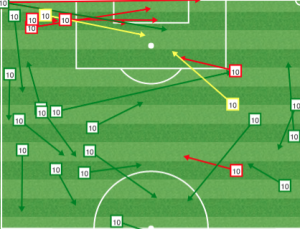

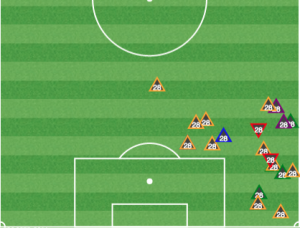
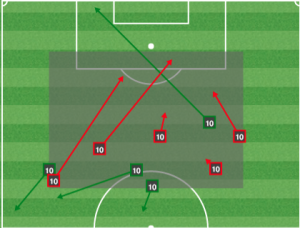
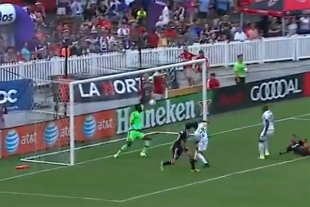

Biggest takeaway for me was the obvious inability for Zach to play the DMid role. He’s clearly best in the 10 spot. With Nogueira out, this spells trouble for us going forward. Any word on Lahoud? We could use him if he’s healthy.
.
Also, I don’t see this game as horribly as everyone else. DC is the best team in the East, we were playing away/tired and Saborio/Espindola combination is straight nasty. They had 85 minutes to climb back from being 2 down. Not the end of the world…(that actually is the Nogueira injury).
@Spugger – I don’t necessarily disagree with your takeaways, but I still think that saying “a team beat us 3-0 over 85 minutes and that isn’t so bad” is a bad place for a team to be.
Great analysis. Sapong has been in beast mode since returning from suspension. He didn’t score vs Portland but he dominated their defense and did so vs DC too every time he had the chance.
Agree with everything else too. Hope the trade of Williams and the termination of Valdes’ contract result in some reinforcments or we will be moving from 19th to 20th in the league (on PPG).
Can a central midfield be slower and less imposing than one made up of Carroll, Fred and Maidana?
Remember when we had BC and Migz?
watching miglioranzi play made me feel like someone threw sand in my eyes
I’m still reeling about that playoff game!
I am on the Start Blake bandwagon. Sylvestre has been capable but he isn’t going to steal us any games.
Agreed. I’m actually very pleased with Sylvestre, but we need to see what Blake can do over a consistent stretch of MLS games. Decisions need to made on MacMath, etc.
It’s not even really about Sylvestre, who has been very serviceable in a weird situation and with bad defending in front of him. It’s really just that Blake was the #1 overall freaking pick, looks to have the talent to be a monster in net, and is healthy now with no legitimate reason not to start him.
I’ve been on the Blake bandwagon since we officially got eliminated from the playoffs last year. We aren’t making the playoffs this year so start Blake ASAP and see what you have over the last 10 games or so. The club has to stop thinking that they can make the playoffs and face reality. Go after the Open Cup and let Blake play the league matches.
+1. And I agree with several people above that Sylvestre has really been fine — as far as I’m concerned, he’s at least earned a spot as backup keep for next year. But Blake is a #1 pick, allegedly the “LeBron James of goalkeepers”, and we absolutely need to see what we have in him. And not just over 2 or 3 games either. He should be given the remainder of this season — and maybe more than that — to show what he’s got. He’s young and will make some “young keeper” mistakes, but maybe we’ll also see some flashes of brilliance.
You’re absolutely right. The Union have made significant investments – money, time, draft picks – in MacMath, Blake, and Mbolhi, but are currently getting NOTHING in return from any of them.
–
Clearly, MacMath and Mbolhi are no longer in the team’s plans, so it is now time to see what Blake can do as a regular in the Union goal.
–
Assuming that he shows signs of living up to his potential, Blake will enter 2016 as a returning starter, with Sylvestre as his able backup.
Isn’t MacMath just a casualty of the M’Bohli situation though? Everything he says on Twitter and Instagram seems to indicate he’s on good terms with his Union teammates. If the Union wanted to sign him for next season, I don’t know what’s stopping them because he’s comparable to the alternatives in many respects, but has more league experience. Not sure how much rust he’s collecting in Colorado though…
Here’s how I see it: If MacMath were in the Union’s long-term plans, then team officials would not have spent valuable resources on two goalkeepers to replace him. Fair or not, I can’t see the Union bringing MacMath back as the number one keeper after spending a top draft pick on Blake and a lot of money on M’Bohli.
He is probably on good terms, but he knows he won’t be the #1 if he comes back. It’s unlikely he’ll be content to be a permanent backup. There are teams that could use a keeper of his ability and will let him start.
Vitoria is healthy right? If that’s the case, and if Nogueira is out for any stretch, I think Edu has to be moved to that role. Zach was way overmatched there and we have 400 thousand reasons to give Vitoria his shot at CB, whether it’s with Marquez or White.
.
Great analysis btw. Curtin continues to make some strange tactical moves, of which many or influenced by the poor roster. I still don’t get the unwillingness to substitute though.
Ummm…..yes.
The man is loyal, perhaps to a fault, but I’d rather overly loyal than a multitude of other sins.
Didn’t Fabhino keep DC onsides and stand and watch the player run by him on the second goal? That to me was a pretty glaring error!
I was going to ask the same question…
YES, yes, and YES again. A 5 for Fabi? NO way. But once again, Adam writes another wonderful in-depth account.
Very good points. I didn’t knock Fabi for sleeping on the second because DeLeon had a darn good running head start.
The roster issues really are glaring. You have a player in Maidana who is an amazing creator but offers nothing on defense and who completely disappears if his teammates aren’t providing options for him. You have a bunch of wingers who seemingly have no plan whatsoever (Wenger, Ayuk, Le Toux). You have Nogueira (when healthy), who is best as a connecting mid. You have a bunch of inconsistent backs. And there’s no depth for anybody. And now we’re potentially adding another offensive guy.
Can we get Okugo back please?
Please no on Okugo. As for Maidana, what is he supposed to do, pass to himself, if his teammates don’t give him an option? What good is a playmaker if there is no one to play the ball to? Which is why I agree with you about the wingers. Ayuk being the only exception. He’s 18 and has talent. I can forgive him a lot. Especially when he actually makes runs into the box for headers, unlike the other two.
I can forgive Le Toux if he’s operating under coach’s orders to push higher up the field.
Maybe I just wish LeToux had more to offer. For me, in Sunday’s game, when he had a pass from Pfeffer, where Pfeffer thought LeToux was gonna make an attacking, positive run, and LeToux just stood there, and then pointed to his feet as if it was absurd that he would go foward, is a fine example of what I really don’t like about him. I’ve said it before, I think he’s a good player on a bad team. And not good enough on a good team. I want more creativity and better runs. Maybe it’s because he plays out of his comfort position. Whatever the reason, for me he isn’t the answer to the questions this team has, unless he’s coming off the bench.
I think that’s reasonable analysis of Le Toux. On the flip side, I think it would be an interesting option for the Union to put him back into his comfort zone, so to speak, and find a way to have him and Sapong partner up top. Being able to run off of a strong hold-up forward seems to be when he’s at his best, at least historically. However, doing that would mean, most likely, abandoning the 3-man center-mid of Carroll/Lahoud – Nog – Maidana.
.
But solving issues like this is why our GM gets paid big bucks, right? Oh, wait… never mind…
simple stuff. If standing still, pass to the feet. the man with the ball has no right to anticipate a run.You make a lead pass if the player is moving in that direction. It shows how poorly the Union does regarding baisic stuff. why should the defense press if that whole thing is not co-ordinated?
Yes, but make the run!
You got it, LeToux was standing still. He shouldn’t have been. He should have been aggressive and attacking. Which was my point. And even more to my point, as you said, LeToux was playing basics, while Pfeffer was in the advanced class, thinking creatively.
Gaddis blowing the coverage on Espindola’s game winner was brilliant.
Phew. Too many ball watcher on Union defense….which to me is incumbent on CB’s to constantly keep cohorts focused. USMNT has same Glaring problem.
Adam…as The Talking Head and the genius that is David Byrne say….’Stop Making Sense.’
.
As I wrote on Sunday concerning the quick 2 gol burst…..the Law of Inevitable Eventuality.
As a onetime journalist, I am consistently impressed with both the erudition and craft on display in these analyses. The Bieber reference is pure gold. Well done, sir.
With the cast of underperforming wingers we have, maybe it’s time to go without wingers??? Try a 4-2-2-2: Sapong and Aristeguieta up top, Maidana and Pfeffer at attacking mid, Nogueira and Carroll (or Lahoud, when he recovers) at d-mid, Fabinho/Edu/Marquez/Gaddis. I know, everyone will say “it’s too narrow” — but we essentially play narrowly already, since we have no wide play now even with wingers on the pitch. Plus, Maidana tends to drift out wide (as Adam notes), Sapong can start stuff from high-wide positions sometimes, and Fabinho makes plenty of runs up the left side. The benefit would be having 3 guys who will GET IN THE BOX, giving Maidana multiple targets. And when teams bear down on Maidana, you have Pfeffer, who is also capable of creating (if you put him in the proper position). I honestly don’t see much downside, except possibly for wide midfield defense.
i’d be interested to see how such a formation would play out
I really was thinking there’s no width to this. But you are right. They aren’t getting good wing play, and they do play narrow. The more I think about it, the more I like it. It’s at least worth a try.
If we had Barcelona’s back four before Puyol retired, maybe. But you’ll clog the middle and yield each outside channel uncontested until the defensive third. That’s an awful lot of crosses, early or late either one, into the box.
These ratings are, as usual, right on.
In your discussion of changed position experiments you left off Exhibit A: Aaron Wheeler to defense. I don’t know where Wheeler is now, but I wonder if Hackworth’s experiment pulled down his career. I worry that Pfeffer’s development is being hurt by being put in bad situations as well.
If we only had a general manager to handle such things……